WP4
Type of resources
Available actions
Topics
Keywords
Contact for the resource
Provided by
Years
Formats
Representation types
Update frequencies
status
Resolution
-
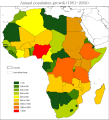
The annual population growth is derived by FAOSTAT dataset, from 1961 to present, and up to 2050 for the projected population. This dataset has been produced in the framework of the "Climate change predictions in Sub-Saharan Africa: impacts and adaptations (ClimAfrica)" project, Work Package 4, Deliverable 4.1 (WP4-D4.1). More information on ClimAfrica project is provided in the Supplemental Information section of this metadata.
-
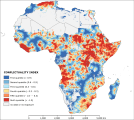
The “conflictuality index” describes the impact that conflicts have in a certain area in 2010. Area subjected to violence and conflict may have problem to receive assistance to develop adaptation measures and may lack the wiliness of the authority to implement such adaptation. The index results from the second cluster of the Principal Component Analysis preformed among 18 potential variables. The analysis identifies two dominant variables, namely “distance from conflict events” and “conflict events density”, assigning equal weights (0.5) to the two variables. Before to perform the analysis the variables were log transformed to shorten the extreme variation and then were score-standardized (converted to distribution with average of 0 and standard deviation of 1; inverse method was applied for “conflicts events density”) in order to be comparable. A shapefile of conflict events was gathered from the Uppsala Conflict Data Programme (UCDP). Considering that the effect of conflict aftermath may during years, we collect all the events position and number of victims from 1989 to 2010. The “distance from conflicts” was obtained via Euclidean distance calculation of the conflict events. The “conflict events density” is the result of a kernel density analysis on number of victims with a search radius of 200 Kilometer. This dataset has been produced in the framework of the “Climate change predictions in Sub-Saharan Africa: impacts and adaptations (ClimAfrica)” project, Work Package 4 (WP4). More information on ClimAfrica project is provided in the Supplemental Information section of this metadata.
-
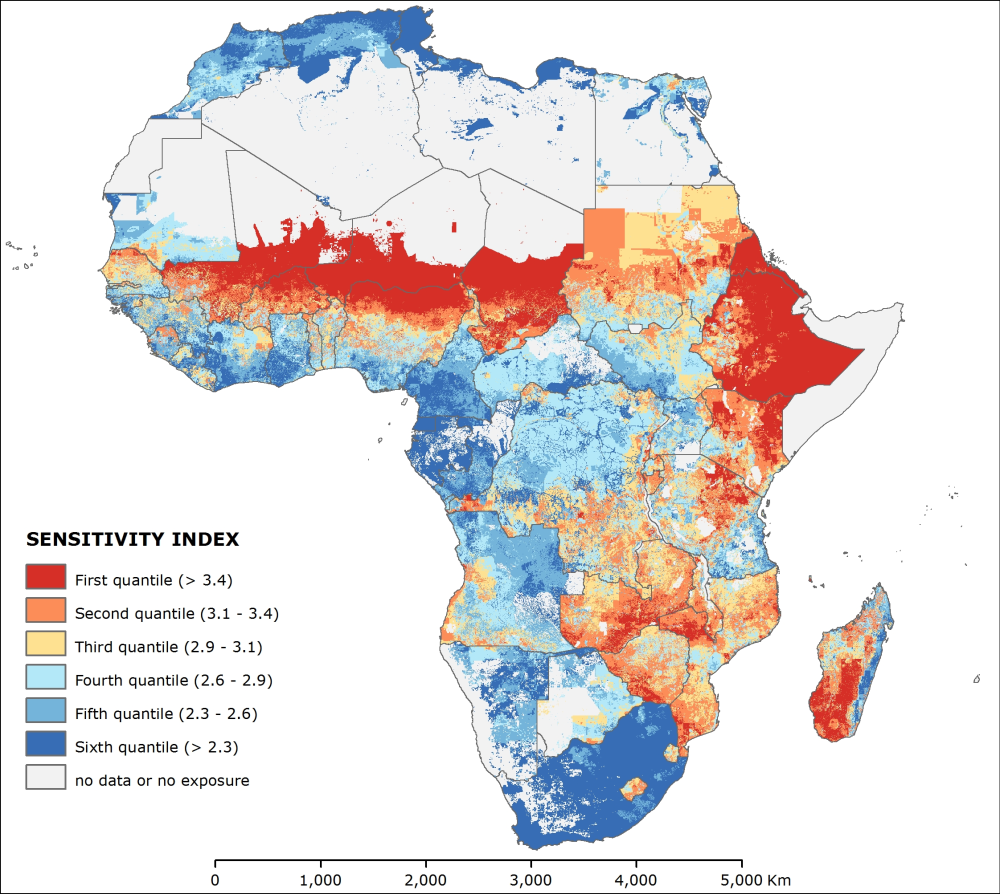
The “sensitivity index” describes the sensitivity or the human–environmental conditions that can worsen the hazard, ameliorate the hazard, or trigger an impact in 2010. Sensitivity in its general sense is defined as the degree to which a system is modified or affected by an internal or external disturbance or set of disturbances. This measure, which herein reflects the responsiveness of a system to climatic influences, is shaped by both socio-economic and ecological conditions and determines the degree to which a group will be affected by environmental stress. Therefore, the “sensitivity index” results from the addition of underlying indexes, namely the “human sensitivity index” and the “natural sensitivity index”, which relative weights are 0.55 and 0.44, respectively. The weights were computed via Principal Component Analysis among the primary variables that compose the two underlying indexes. This dataset has been produced in the framework of the “Climate change predictions in Sub-Saharan Africa: impacts and adaptations (ClimAfrica)” project, Work Package 4 (WP4). More information on ClimAfrica project is provided in the Supplemental Information section of this metadata.
-
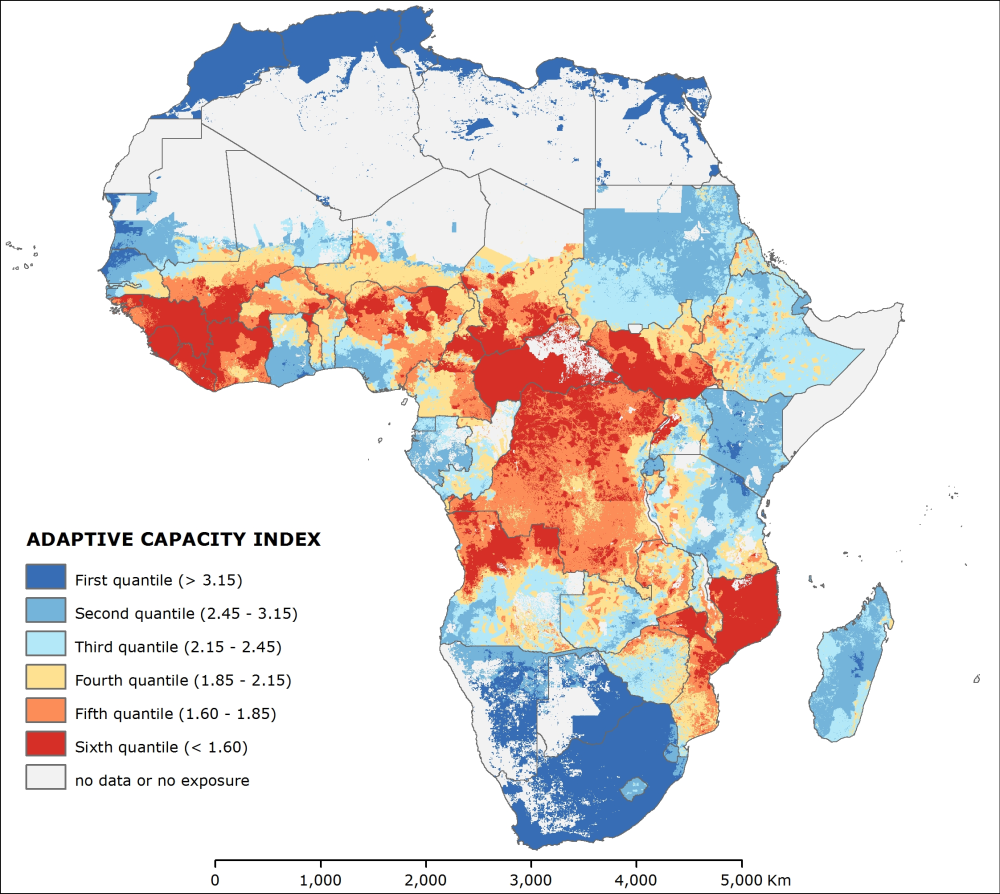
The “adaptive capacity index” symbolizes the adaptive potential to implement adaptation measures that help avert potential impacts in 2010. Adaptive capacity is a significant factor in characterizing vulnerability. The IPCC (2001) describes adaptive capacity as the potential or ability of a system, region, or community to adjust to the effects or impacts of climate change (including climate variability and extremes). Adaptive capacity is considered to be “a function of wealth, technology, education, information, infrastructure, skills, access to resources and stability and management capabilities”. The means of the adaptive capacity are the assets and entitlements that communities and individuals can mobilize in the face of environmental change. The more assets people have, the less vulnerable they are and vice versa. Here adaptive capacity is described as being dependent upon four assets: human capital, technological capital, financial capital and institutional capital. Therefore, the “adaptive capacity index” derived from the addition of four underlying indexes: the “human capital index”, the “technological capital index”, the “financial capital index” and the “institutional capital index”. Principal Component Analysis determines the weights of the four underlying indexes. The analysis run among the variables that compose such indexes and results in four weights: 0.58 for the “human capital index”, 0.16 for the “technological capital index”, 0.20 for the “financial capital index” and finally 0.06 for the “institutional capital index”. This dataset has been produced in the framework of the “Climate change predictions in Sub-Saharan Africa: impacts and adaptations (ClimAfrica)” project, Work Package 4 (WP4). More information on ClimAfrica project is provided in the Supplemental Information section of this metadata.
-
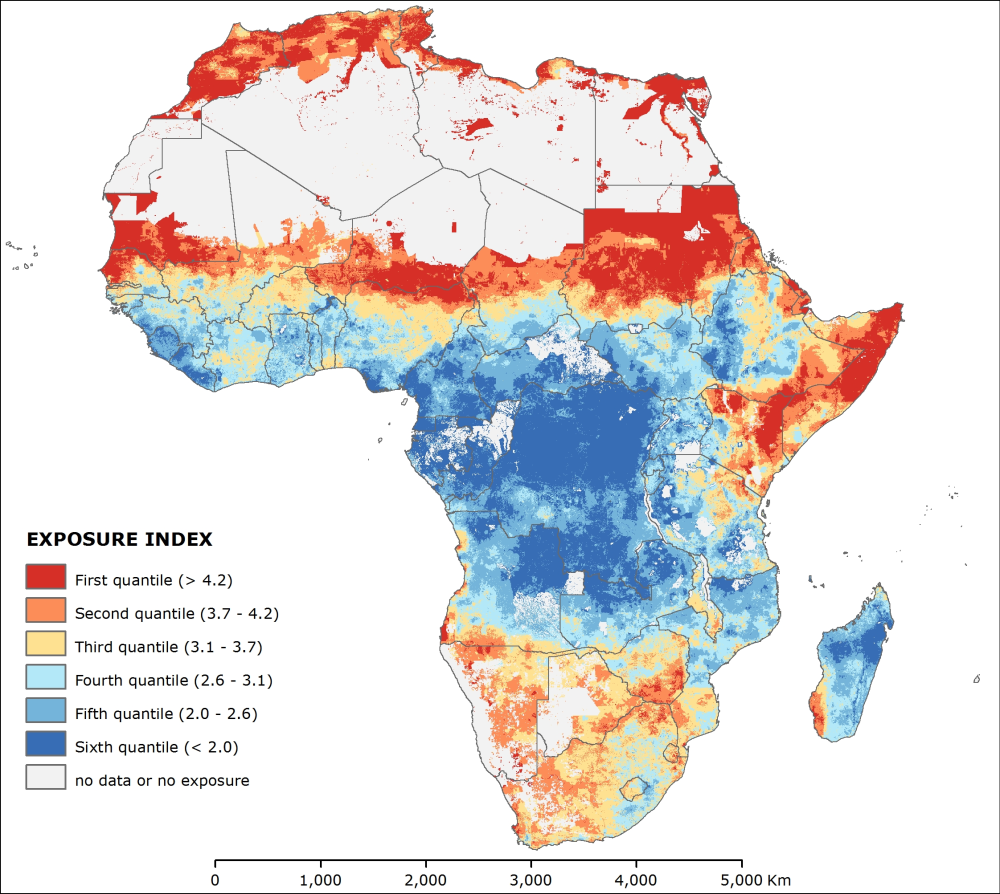
The “exposure index” relates to exposure that is the degree of climatic stress upon a particular unit of analysis or element at risk in 2010. The exposure is commonly defined like the combination between the density of element at risk and a hazard. Here the elements at risk are people, livestock units and crop land and the hazard is the climate change and its impacts. Thus the index results from the addition of two underlying indexes: the “element at risk index” and the “climatic stress index”. The relative weights of underlying indexes were 0.28 and 0.72 respectively for the “element at risk” and the “climatic stress indexes”. These weights were defined through Principal Component Analysis (retaining three components) among ten variables which compose the two underlying indexes. This dataset has been produced in the framework of the “Climate change predictions in Sub-Saharan Africa: impacts and adaptations (ClimAfrica)” project, Work Package 4 (WP4). More information on ClimAfrica project is provided in the Supplemental Information section of this metadata.
-
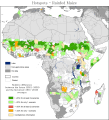
Hotspots zones have been identified for each agro-climatic and climatic parameter and future period, based on the yield anomaly classes (relative differences between the future and the historical period). For each crop and each period, the hotspots are represented by 5 classes: - Zones with a high decrease (>20%) for at least one scenario - Zones with a high decrease (>20%) for at least two scenarios - Zones with a high increase (>20%) for at least one scenario - Zones with a high increase (>20%) for at least two scenarios - Zones with a contradictory information between models This data set has been produced in the framework of the “Climate change predictions in Sub-Saharan Africa: impacts and adaptations (ClimAfrica)” project, Work Package 4 (WP4). More information on ClimAfrica project is provided in the Supplemental Information section of this metadata..
-
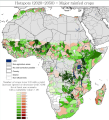
The hotspots zones of all the rainfed crops have been combined with the suitability classes as follow. The number of crops with a yield increase or decrease of more than 10 and 20% has been computed considering two suitability thresholds: one above 0% and another one above 40%. The results have been mapped showing the areas with positive impact in green and the areas with a negative impact in red. One map has been produced considering at least one scenario showing the same trend and the other one considering at least two scenarios showing the same trend. This data set has been produced in the framework of the “Climate change predictions in Sub-Saharan Africa: impacts and adaptations (ClimAfrica)” project, Work Package 4 (WP4). More information on ClimAfrica project is provided in the Supplemental Information section of this metadata.
-
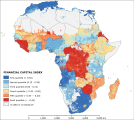
The “financial capital index” represents the economic means that determine the potential adaptive capacity degree of a particular unit of analysis in 2010. It is linked with the richness and the attained degree of economical development of a certain population. It is the combination of two underlying indexes: the “financial development index” and the “richness index”. These original indexes correspond to the two principal components identified by Principal Component Analysis among 9 potential variables. The analysis assigned relative weights to the “financial development index” and the “richness index”, that are 0.51 and 0.49, respectively. This dataset has been produced in the framework of the “Climate change predictions in Sub-Saharan Africa: impacts and adaptations (ClimAfrica)” project, Work Package 4 (WP4). More information on ClimAfrica project is provided in the Supplemental Information section of this metadata. This dataset has been produced in the framework of the “Climate change predictions in Sub-Saharan Africa: impacts and adaptations (ClimAfrica)” project, Work Package 4 (WP4). More information on ClimAfrica project is provided in the Supplemental Information section of this metadata.
-
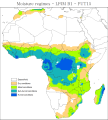
The moisture regimes are determined by the agro-climatic conditions. Two inputs from the ClimAfrica project are used to produce this data set: the LGP equivalent (LGPeq) and the Aridity Index over the LGPt season (AI LGPt). This analysis is done for the model LPJ-ml, for five 30-year periods. This data set has been produced in the framework of the “Climate change predictions in Sub-Saharan Africa: impacts and adaptations (ClimAfrica)” project, Work Package 4 (WP4). More information on ClimAfrica project is provided in the Supplemental Information section of this metadata.
-
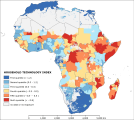
The “household technology index” relates to the diffusion of daily necessity technology in a certain area in 2010. High rate of access to such technology is an indicator of quality of life and wellbeing condition of the population, and thus, those with the capacity to cope and face better climate change impacts. The index results from the first cluster of the Principal Component Analysis preformed among 10 potential variables. The analysis identifies four dominant variables, namely “access to improved water source”, “access to improved sanitation facilities”, “electrification rate” and “mobile phone subscriptions”, assigning an equal weight of 0.25 to the four variables. Before to perform the analysis “electrification rate” and “mobile phone penetration” were log transformed to shorten the extreme variation and then with the other two variable were score-standardized (converted to distribution with average of 0 and standard deviation of 1) in order to be comparable. The first administrative level data for the “access to improved water source” (the share of the population with reasonable access to any of the following types of water supply for drinking: household connections, public standpipes, boreholes, protected dug wells, protected springs and rainwater collection. Reasonable access is defined as the availability of at least 20 liters a person per day from a source within one kilometer of the user’s dwelling.) and “access to improved sanitation facilities” (the share of the population with access to comprise flush toilets, piped sewer systems, septic tanks, flush/pour flush to pit latrines, ventilated improved pit latrines, pit latrines with slab and composting toilets) were gathered from DHS, UNDP National Human Development Reports, WHO/UNICEF statistics, and in some cases national survey data (data range from 1998 to 2012). Tabular data were linked by first administrative unit to the first administrative boundaries shapefile (FAO/GAUL) and then converted into raster format (resolution 0.5 arc-minute). The first administrative level data for the “electrification rate” of 2006 (percentage of population with access to electricity) was produced by NOAA National Geophysical Data Center. It is an estimation based on night light satellite picture. Tabular data were linked by first administrative unit to the first administrative boundaries shapefile (FAO/GAUL) and then converted into raster format (resolution 0.5 arc-minute). The country based data for the “mobile phone subscriptions” were gathered from World Bank. It records the average number of subscriptions to a public mobile telephone service using cellular technology per 100 people in the period 2008-2012. Post-paid and prepaid subscriptions are included. Tabular data were linked by country unit to the national boundaries shapefile (FAO/GAUL) and then converted into raster format (resolution 0.5 arc-minute). These variables have been identified as a key indicator of adaptive capacity, and thus vulnerability, at many levels by different authors (e.g. Brooks et al. 2005; Bollin & Hidajat 2006). In particular improved sanitation facilities prevent insect and animal contact, which are agents of diarrhea, and also reduce other non-diarrhea related health outcomes. Improved water sources can significantly lower the risk of water-borne diseases, which, in turn, has in its turn a positive impact on people's health status (Esrey & Habicht 1986). In other words, improved sanitation facilities and water sources should get better growth rates and reduce child mortality rates. This dataset has been produced in the framework of the “Climate change predictions in Sub-Saharan Africa: impacts and adaptations (ClimAfrica)” project, Work Package 4 (WP4). More information on ClimAfrica project is provided in the Supplemental Information section of this metadata.
 FAO Map Catalog
FAO Map Catalog